SWM518: Health Care Expenditure Growth and Its Drivers in Australia
VerifiedAdded on 2022/11/03
|14
|3682
|454
Essay
AI Summary
This essay delves into the multifaceted drivers of health care expenditure growth, with a particular emphasis on the impact of unhealthy lifestyles. It examines how factors such as tobacco use, substance abuse, poor diet, and lack of physical activity contribute to the rising costs of healthcare, especially in the context of chronic diseases like cardiovascular diseases, diabetes, and cancer. The essay provides an overview of the Australian healthcare system, analyzing the economic impact of these trends and exploring the role of government and policy interventions in mitigating rising healthcare costs. Furthermore, the essay provides counterarguments and a balanced perspective by acknowledging other factors, such as technological advancements and an aging population, that influence healthcare spending, ultimately advocating for a comprehensive approach that includes both individual lifestyle changes and broader policy implementation to address this critical issue.
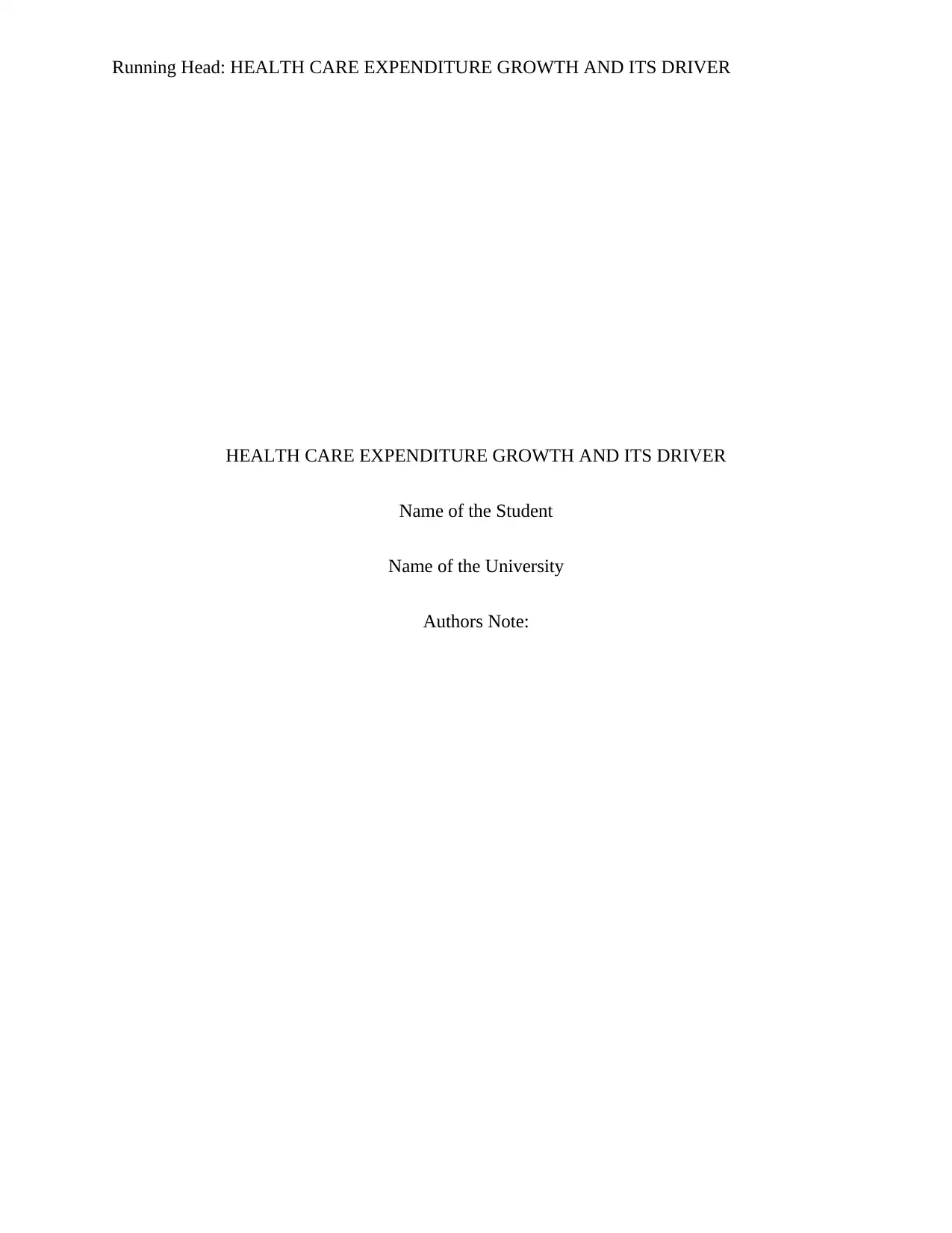
Running Head: HEALTH CARE EXPENDITURE GROWTH AND ITS DRIVER
HEALTH CARE EXPENDITURE GROWTH AND ITS DRIVER
Name of the Student
Name of the University
Authors Note:
HEALTH CARE EXPENDITURE GROWTH AND ITS DRIVER
Name of the Student
Name of the University
Authors Note:
Paraphrase This Document
Need a fresh take? Get an instant paraphrase of this document with our AI Paraphraser
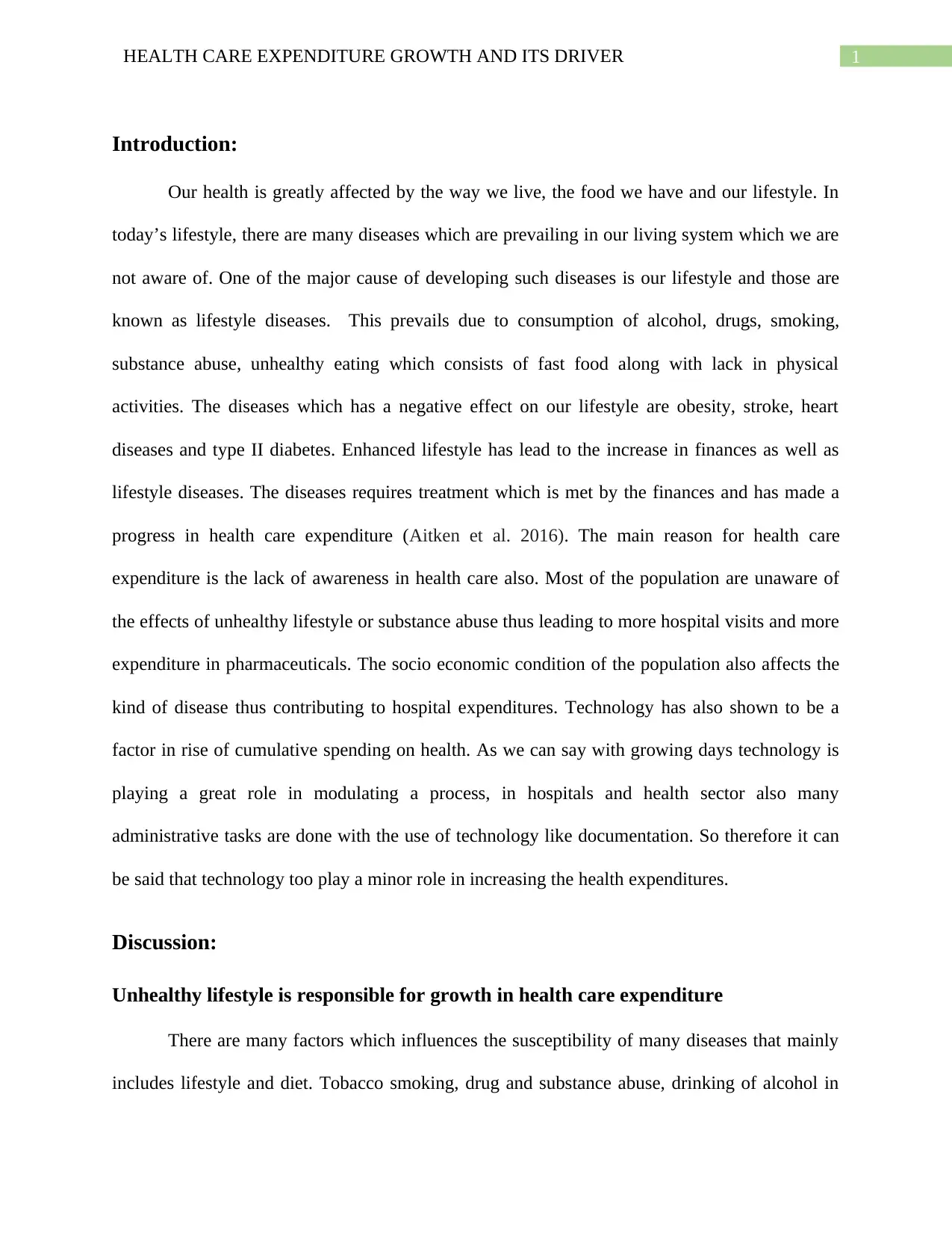
1HEALTH CARE EXPENDITURE GROWTH AND ITS DRIVER
Introduction:
Our health is greatly affected by the way we live, the food we have and our lifestyle. In
today’s lifestyle, there are many diseases which are prevailing in our living system which we are
not aware of. One of the major cause of developing such diseases is our lifestyle and those are
known as lifestyle diseases. This prevails due to consumption of alcohol, drugs, smoking,
substance abuse, unhealthy eating which consists of fast food along with lack in physical
activities. The diseases which has a negative effect on our lifestyle are obesity, stroke, heart
diseases and type II diabetes. Enhanced lifestyle has lead to the increase in finances as well as
lifestyle diseases. The diseases requires treatment which is met by the finances and has made a
progress in health care expenditure (Aitken et al. 2016). The main reason for health care
expenditure is the lack of awareness in health care also. Most of the population are unaware of
the effects of unhealthy lifestyle or substance abuse thus leading to more hospital visits and more
expenditure in pharmaceuticals. The socio economic condition of the population also affects the
kind of disease thus contributing to hospital expenditures. Technology has also shown to be a
factor in rise of cumulative spending on health. As we can say with growing days technology is
playing a great role in modulating a process, in hospitals and health sector also many
administrative tasks are done with the use of technology like documentation. So therefore it can
be said that technology too play a minor role in increasing the health expenditures.
Discussion:
Unhealthy lifestyle is responsible for growth in health care expenditure
There are many factors which influences the susceptibility of many diseases that mainly
includes lifestyle and diet. Tobacco smoking, drug and substance abuse, drinking of alcohol in
Introduction:
Our health is greatly affected by the way we live, the food we have and our lifestyle. In
today’s lifestyle, there are many diseases which are prevailing in our living system which we are
not aware of. One of the major cause of developing such diseases is our lifestyle and those are
known as lifestyle diseases. This prevails due to consumption of alcohol, drugs, smoking,
substance abuse, unhealthy eating which consists of fast food along with lack in physical
activities. The diseases which has a negative effect on our lifestyle are obesity, stroke, heart
diseases and type II diabetes. Enhanced lifestyle has lead to the increase in finances as well as
lifestyle diseases. The diseases requires treatment which is met by the finances and has made a
progress in health care expenditure (Aitken et al. 2016). The main reason for health care
expenditure is the lack of awareness in health care also. Most of the population are unaware of
the effects of unhealthy lifestyle or substance abuse thus leading to more hospital visits and more
expenditure in pharmaceuticals. The socio economic condition of the population also affects the
kind of disease thus contributing to hospital expenditures. Technology has also shown to be a
factor in rise of cumulative spending on health. As we can say with growing days technology is
playing a great role in modulating a process, in hospitals and health sector also many
administrative tasks are done with the use of technology like documentation. So therefore it can
be said that technology too play a minor role in increasing the health expenditures.
Discussion:
Unhealthy lifestyle is responsible for growth in health care expenditure
There are many factors which influences the susceptibility of many diseases that mainly
includes lifestyle and diet. Tobacco smoking, drug and substance abuse, drinking of alcohol in
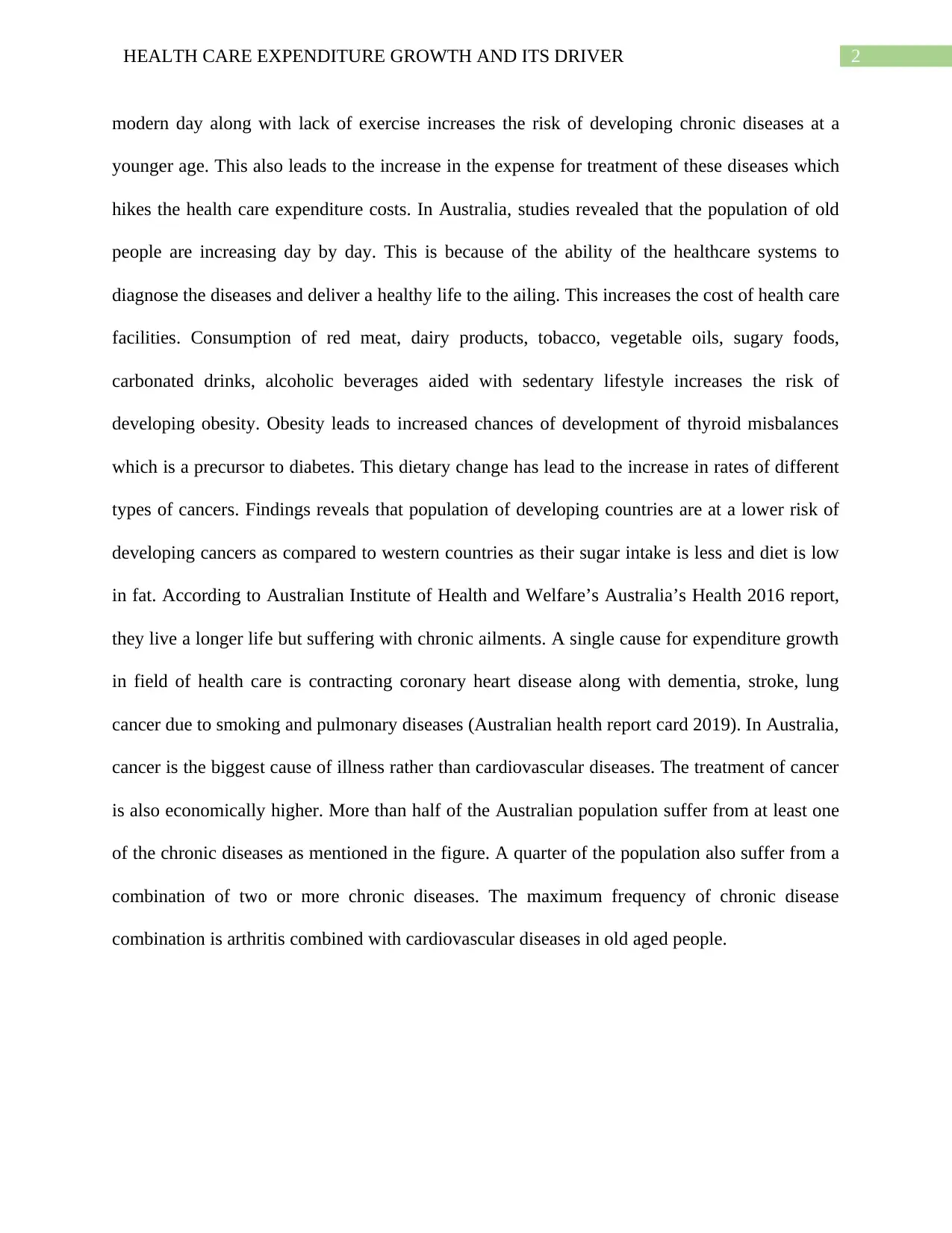
2HEALTH CARE EXPENDITURE GROWTH AND ITS DRIVER
modern day along with lack of exercise increases the risk of developing chronic diseases at a
younger age. This also leads to the increase in the expense for treatment of these diseases which
hikes the health care expenditure costs. In Australia, studies revealed that the population of old
people are increasing day by day. This is because of the ability of the healthcare systems to
diagnose the diseases and deliver a healthy life to the ailing. This increases the cost of health care
facilities. Consumption of red meat, dairy products, tobacco, vegetable oils, sugary foods,
carbonated drinks, alcoholic beverages aided with sedentary lifestyle increases the risk of
developing obesity. Obesity leads to increased chances of development of thyroid misbalances
which is a precursor to diabetes. This dietary change has lead to the increase in rates of different
types of cancers. Findings reveals that population of developing countries are at a lower risk of
developing cancers as compared to western countries as their sugar intake is less and diet is low
in fat. According to Australian Institute of Health and Welfare’s Australia’s Health 2016 report,
they live a longer life but suffering with chronic ailments. A single cause for expenditure growth
in field of health care is contracting coronary heart disease along with dementia, stroke, lung
cancer due to smoking and pulmonary diseases (Australian health report card 2019). In Australia,
cancer is the biggest cause of illness rather than cardiovascular diseases. The treatment of cancer
is also economically higher. More than half of the Australian population suffer from at least one
of the chronic diseases as mentioned in the figure. A quarter of the population also suffer from a
combination of two or more chronic diseases. The maximum frequency of chronic disease
combination is arthritis combined with cardiovascular diseases in old aged people.
modern day along with lack of exercise increases the risk of developing chronic diseases at a
younger age. This also leads to the increase in the expense for treatment of these diseases which
hikes the health care expenditure costs. In Australia, studies revealed that the population of old
people are increasing day by day. This is because of the ability of the healthcare systems to
diagnose the diseases and deliver a healthy life to the ailing. This increases the cost of health care
facilities. Consumption of red meat, dairy products, tobacco, vegetable oils, sugary foods,
carbonated drinks, alcoholic beverages aided with sedentary lifestyle increases the risk of
developing obesity. Obesity leads to increased chances of development of thyroid misbalances
which is a precursor to diabetes. This dietary change has lead to the increase in rates of different
types of cancers. Findings reveals that population of developing countries are at a lower risk of
developing cancers as compared to western countries as their sugar intake is less and diet is low
in fat. According to Australian Institute of Health and Welfare’s Australia’s Health 2016 report,
they live a longer life but suffering with chronic ailments. A single cause for expenditure growth
in field of health care is contracting coronary heart disease along with dementia, stroke, lung
cancer due to smoking and pulmonary diseases (Australian health report card 2019). In Australia,
cancer is the biggest cause of illness rather than cardiovascular diseases. The treatment of cancer
is also economically higher. More than half of the Australian population suffer from at least one
of the chronic diseases as mentioned in the figure. A quarter of the population also suffer from a
combination of two or more chronic diseases. The maximum frequency of chronic disease
combination is arthritis combined with cardiovascular diseases in old aged people.
⊘ This is a preview!⊘
Do you want full access?
Subscribe today to unlock all pages.

Trusted by 1+ million students worldwide
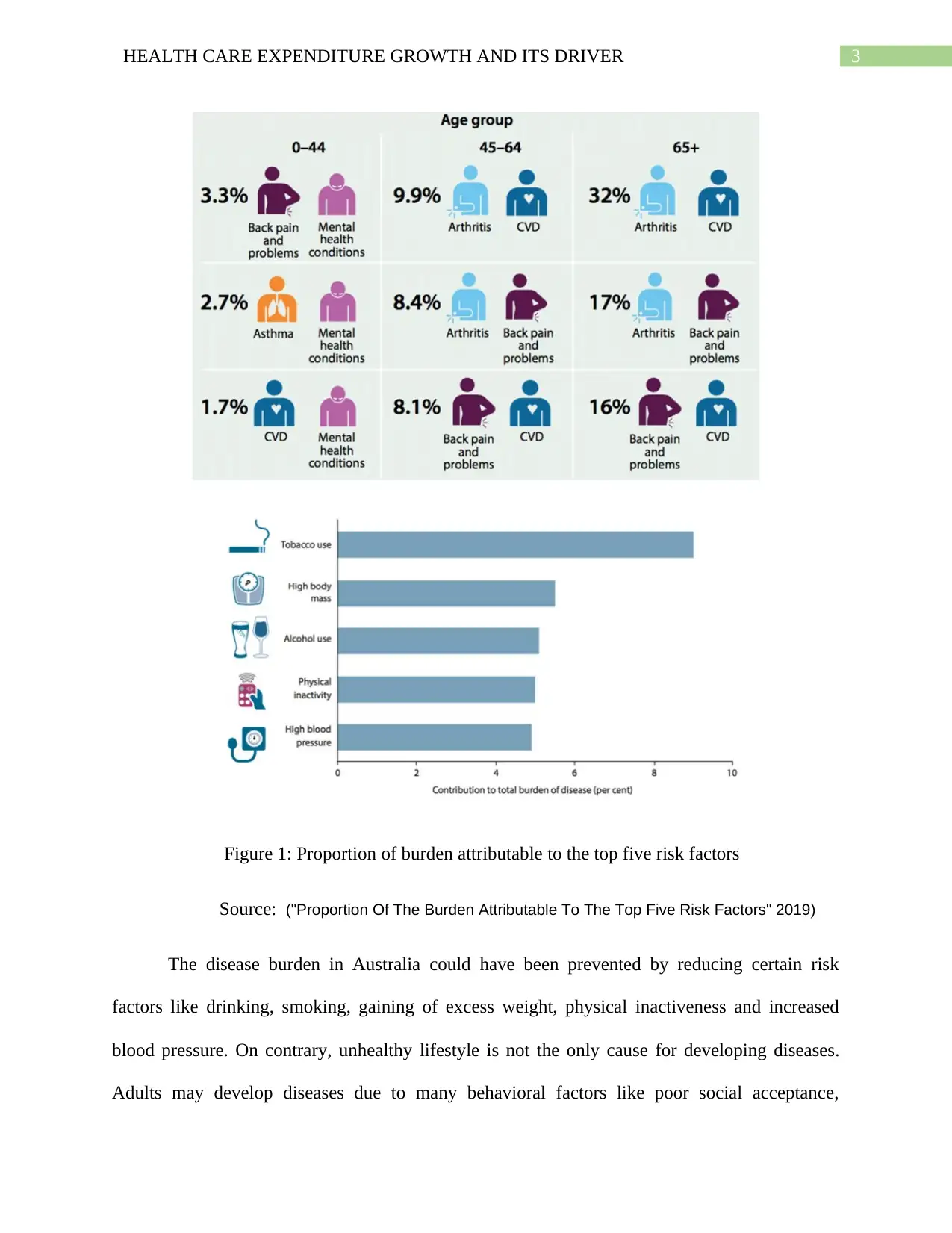
3HEALTH CARE EXPENDITURE GROWTH AND ITS DRIVER
Figure 1: Proportion of burden attributable to the top five risk factors
Source: ("Proportion Of The Burden Attributable To The Top Five Risk Factors" 2019)
The disease burden in Australia could have been prevented by reducing certain risk
factors like drinking, smoking, gaining of excess weight, physical inactiveness and increased
blood pressure. On contrary, unhealthy lifestyle is not the only cause for developing diseases.
Adults may develop diseases due to many behavioral factors like poor social acceptance,
Figure 1: Proportion of burden attributable to the top five risk factors
Source: ("Proportion Of The Burden Attributable To The Top Five Risk Factors" 2019)
The disease burden in Australia could have been prevented by reducing certain risk
factors like drinking, smoking, gaining of excess weight, physical inactiveness and increased
blood pressure. On contrary, unhealthy lifestyle is not the only cause for developing diseases.
Adults may develop diseases due to many behavioral factors like poor social acceptance,
Paraphrase This Document
Need a fresh take? Get an instant paraphrase of this document with our AI Paraphraser
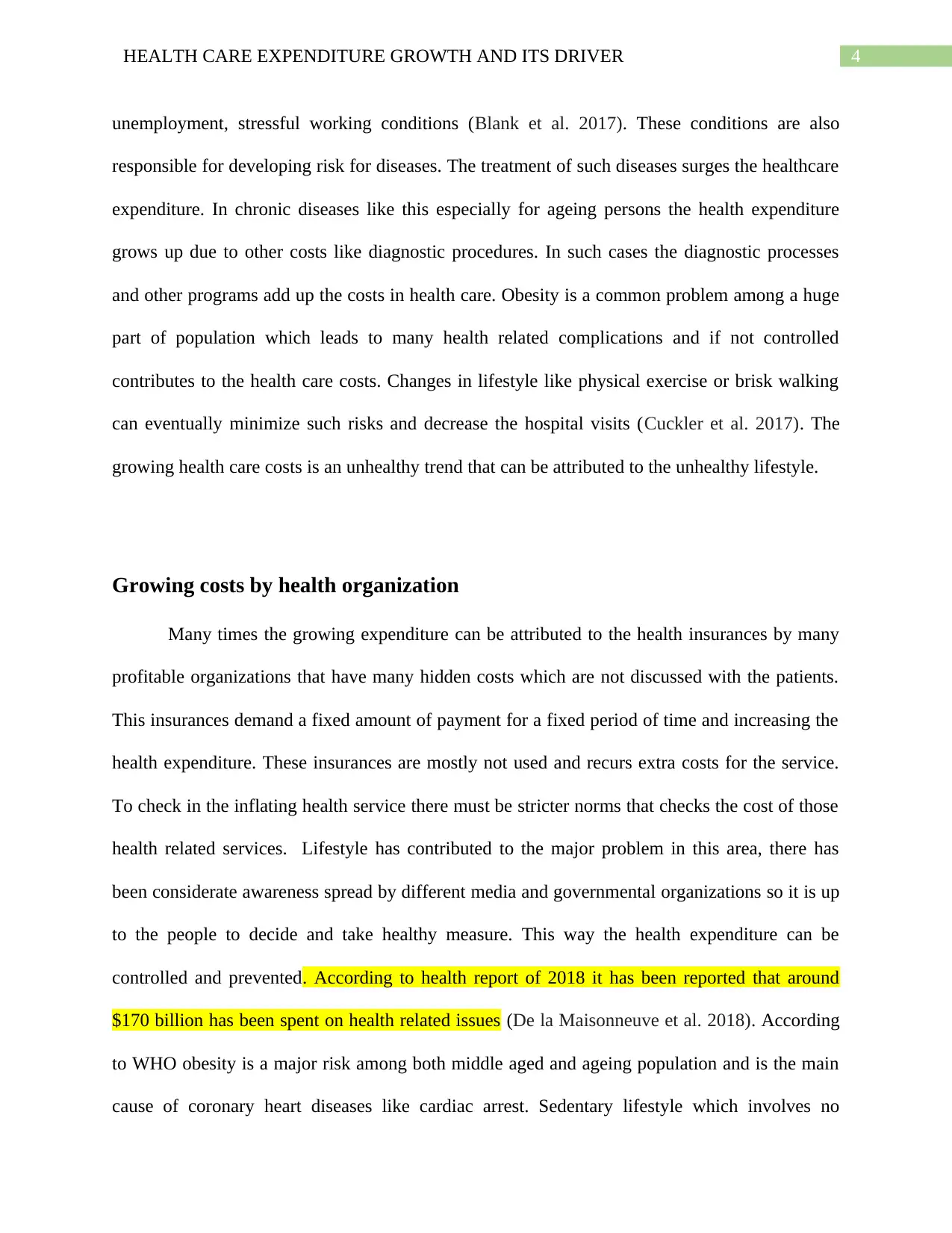
4HEALTH CARE EXPENDITURE GROWTH AND ITS DRIVER
unemployment, stressful working conditions (Blank et al. 2017). These conditions are also
responsible for developing risk for diseases. The treatment of such diseases surges the healthcare
expenditure. In chronic diseases like this especially for ageing persons the health expenditure
grows up due to other costs like diagnostic procedures. In such cases the diagnostic processes
and other programs add up the costs in health care. Obesity is a common problem among a huge
part of population which leads to many health related complications and if not controlled
contributes to the health care costs. Changes in lifestyle like physical exercise or brisk walking
can eventually minimize such risks and decrease the hospital visits (Cuckler et al. 2017). The
growing health care costs is an unhealthy trend that can be attributed to the unhealthy lifestyle.
Growing costs by health organization
Many times the growing expenditure can be attributed to the health insurances by many
profitable organizations that have many hidden costs which are not discussed with the patients.
This insurances demand a fixed amount of payment for a fixed period of time and increasing the
health expenditure. These insurances are mostly not used and recurs extra costs for the service.
To check in the inflating health service there must be stricter norms that checks the cost of those
health related services. Lifestyle has contributed to the major problem in this area, there has
been considerate awareness spread by different media and governmental organizations so it is up
to the people to decide and take healthy measure. This way the health expenditure can be
controlled and prevented. According to health report of 2018 it has been reported that around
$170 billion has been spent on health related issues (De la Maisonneuve et al. 2018). According
to WHO obesity is a major risk among both middle aged and ageing population and is the main
cause of coronary heart diseases like cardiac arrest. Sedentary lifestyle which involves no
unemployment, stressful working conditions (Blank et al. 2017). These conditions are also
responsible for developing risk for diseases. The treatment of such diseases surges the healthcare
expenditure. In chronic diseases like this especially for ageing persons the health expenditure
grows up due to other costs like diagnostic procedures. In such cases the diagnostic processes
and other programs add up the costs in health care. Obesity is a common problem among a huge
part of population which leads to many health related complications and if not controlled
contributes to the health care costs. Changes in lifestyle like physical exercise or brisk walking
can eventually minimize such risks and decrease the hospital visits (Cuckler et al. 2017). The
growing health care costs is an unhealthy trend that can be attributed to the unhealthy lifestyle.
Growing costs by health organization
Many times the growing expenditure can be attributed to the health insurances by many
profitable organizations that have many hidden costs which are not discussed with the patients.
This insurances demand a fixed amount of payment for a fixed period of time and increasing the
health expenditure. These insurances are mostly not used and recurs extra costs for the service.
To check in the inflating health service there must be stricter norms that checks the cost of those
health related services. Lifestyle has contributed to the major problem in this area, there has
been considerate awareness spread by different media and governmental organizations so it is up
to the people to decide and take healthy measure. This way the health expenditure can be
controlled and prevented. According to health report of 2018 it has been reported that around
$170 billion has been spent on health related issues (De la Maisonneuve et al. 2018). According
to WHO obesity is a major risk among both middle aged and ageing population and is the main
cause of coronary heart diseases like cardiac arrest. Sedentary lifestyle which involves no
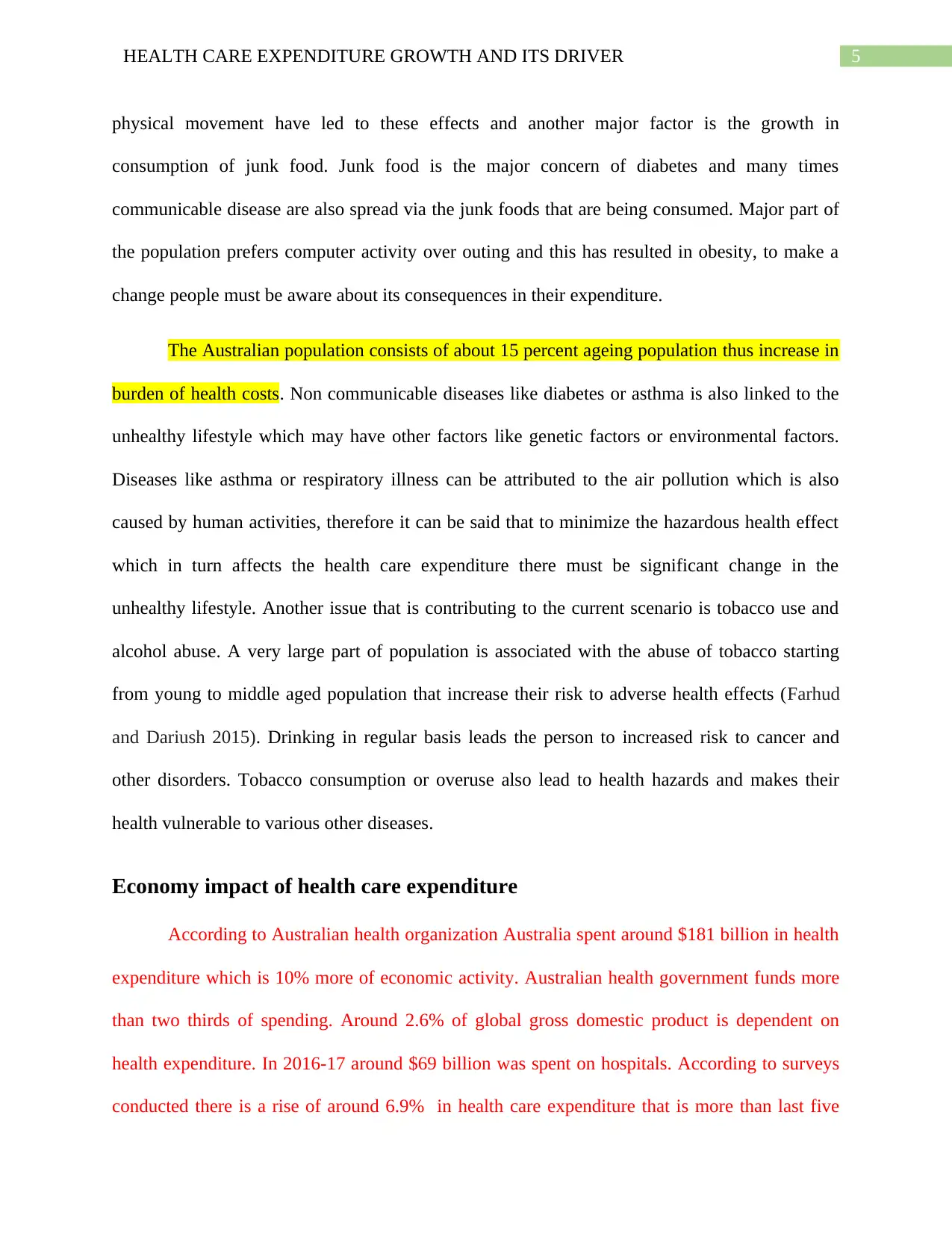
5HEALTH CARE EXPENDITURE GROWTH AND ITS DRIVER
physical movement have led to these effects and another major factor is the growth in
consumption of junk food. Junk food is the major concern of diabetes and many times
communicable disease are also spread via the junk foods that are being consumed. Major part of
the population prefers computer activity over outing and this has resulted in obesity, to make a
change people must be aware about its consequences in their expenditure.
The Australian population consists of about 15 percent ageing population thus increase in
burden of health costs. Non communicable diseases like diabetes or asthma is also linked to the
unhealthy lifestyle which may have other factors like genetic factors or environmental factors.
Diseases like asthma or respiratory illness can be attributed to the air pollution which is also
caused by human activities, therefore it can be said that to minimize the hazardous health effect
which in turn affects the health care expenditure there must be significant change in the
unhealthy lifestyle. Another issue that is contributing to the current scenario is tobacco use and
alcohol abuse. A very large part of population is associated with the abuse of tobacco starting
from young to middle aged population that increase their risk to adverse health effects (Farhud
and Dariush 2015). Drinking in regular basis leads the person to increased risk to cancer and
other disorders. Tobacco consumption or overuse also lead to health hazards and makes their
health vulnerable to various other diseases.
Economy impact of health care expenditure
According to Australian health organization Australia spent around $181 billion in health
expenditure which is 10% more of economic activity. Australian health government funds more
than two thirds of spending. Around 2.6% of global gross domestic product is dependent on
health expenditure. In 2016-17 around $69 billion was spent on hospitals. According to surveys
conducted there is a rise of around 6.9% in health care expenditure that is more than last five
physical movement have led to these effects and another major factor is the growth in
consumption of junk food. Junk food is the major concern of diabetes and many times
communicable disease are also spread via the junk foods that are being consumed. Major part of
the population prefers computer activity over outing and this has resulted in obesity, to make a
change people must be aware about its consequences in their expenditure.
The Australian population consists of about 15 percent ageing population thus increase in
burden of health costs. Non communicable diseases like diabetes or asthma is also linked to the
unhealthy lifestyle which may have other factors like genetic factors or environmental factors.
Diseases like asthma or respiratory illness can be attributed to the air pollution which is also
caused by human activities, therefore it can be said that to minimize the hazardous health effect
which in turn affects the health care expenditure there must be significant change in the
unhealthy lifestyle. Another issue that is contributing to the current scenario is tobacco use and
alcohol abuse. A very large part of population is associated with the abuse of tobacco starting
from young to middle aged population that increase their risk to adverse health effects (Farhud
and Dariush 2015). Drinking in regular basis leads the person to increased risk to cancer and
other disorders. Tobacco consumption or overuse also lead to health hazards and makes their
health vulnerable to various other diseases.
Economy impact of health care expenditure
According to Australian health organization Australia spent around $181 billion in health
expenditure which is 10% more of economic activity. Australian health government funds more
than two thirds of spending. Around 2.6% of global gross domestic product is dependent on
health expenditure. In 2016-17 around $69 billion was spent on hospitals. According to surveys
conducted there is a rise of around 6.9% in health care expenditure that is more than last five
⊘ This is a preview!⊘
Do you want full access?
Subscribe today to unlock all pages.

Trusted by 1+ million students worldwide
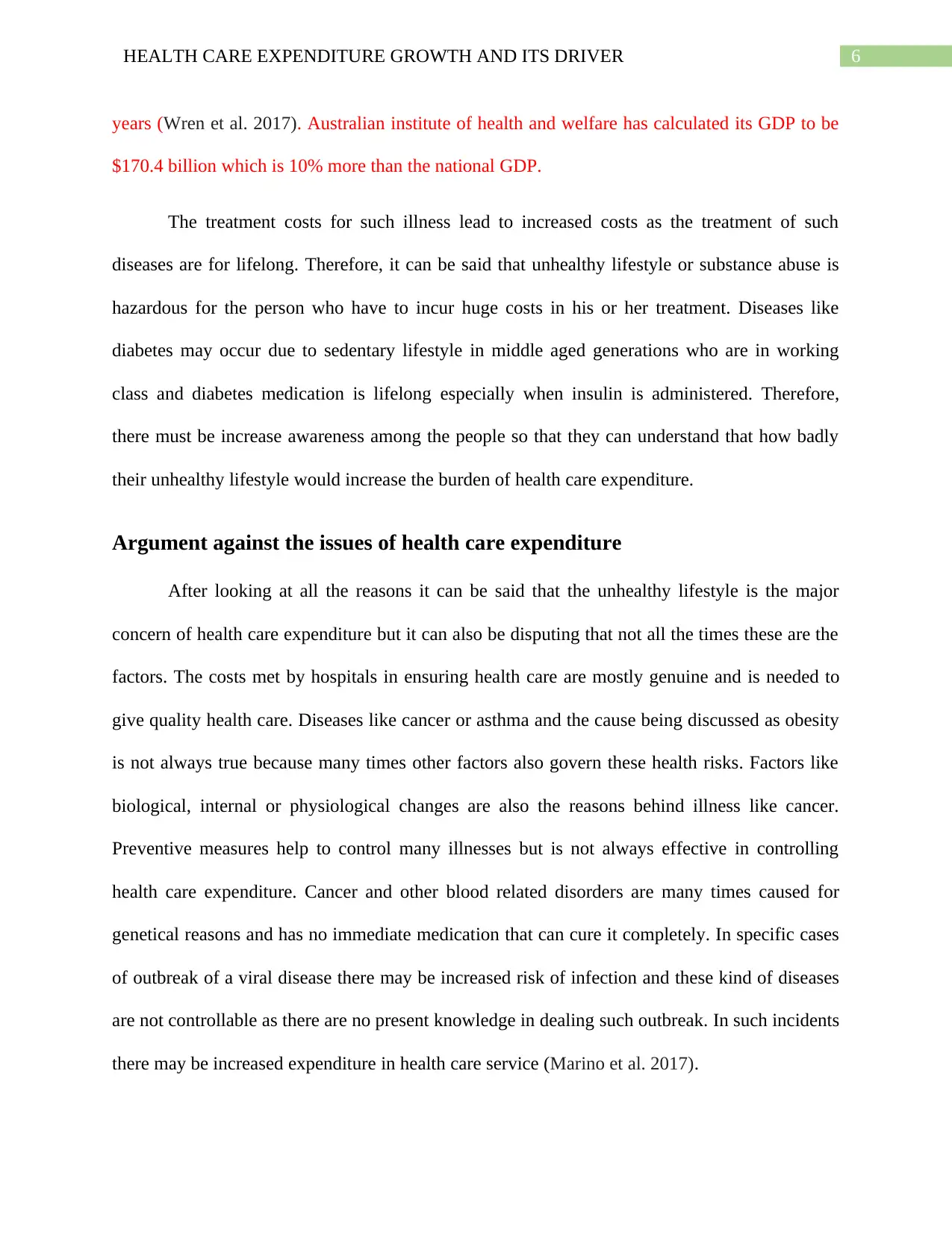
6HEALTH CARE EXPENDITURE GROWTH AND ITS DRIVER
years (Wren et al. 2017). Australian institute of health and welfare has calculated its GDP to be
$170.4 billion which is 10% more than the national GDP.
The treatment costs for such illness lead to increased costs as the treatment of such
diseases are for lifelong. Therefore, it can be said that unhealthy lifestyle or substance abuse is
hazardous for the person who have to incur huge costs in his or her treatment. Diseases like
diabetes may occur due to sedentary lifestyle in middle aged generations who are in working
class and diabetes medication is lifelong especially when insulin is administered. Therefore,
there must be increase awareness among the people so that they can understand that how badly
their unhealthy lifestyle would increase the burden of health care expenditure.
Argument against the issues of health care expenditure
After looking at all the reasons it can be said that the unhealthy lifestyle is the major
concern of health care expenditure but it can also be disputing that not all the times these are the
factors. The costs met by hospitals in ensuring health care are mostly genuine and is needed to
give quality health care. Diseases like cancer or asthma and the cause being discussed as obesity
is not always true because many times other factors also govern these health risks. Factors like
biological, internal or physiological changes are also the reasons behind illness like cancer.
Preventive measures help to control many illnesses but is not always effective in controlling
health care expenditure. Cancer and other blood related disorders are many times caused for
genetical reasons and has no immediate medication that can cure it completely. In specific cases
of outbreak of a viral disease there may be increased risk of infection and these kind of diseases
are not controllable as there are no present knowledge in dealing such outbreak. In such incidents
there may be increased expenditure in health care service (Marino et al. 2017).
years (Wren et al. 2017). Australian institute of health and welfare has calculated its GDP to be
$170.4 billion which is 10% more than the national GDP.
The treatment costs for such illness lead to increased costs as the treatment of such
diseases are for lifelong. Therefore, it can be said that unhealthy lifestyle or substance abuse is
hazardous for the person who have to incur huge costs in his or her treatment. Diseases like
diabetes may occur due to sedentary lifestyle in middle aged generations who are in working
class and diabetes medication is lifelong especially when insulin is administered. Therefore,
there must be increase awareness among the people so that they can understand that how badly
their unhealthy lifestyle would increase the burden of health care expenditure.
Argument against the issues of health care expenditure
After looking at all the reasons it can be said that the unhealthy lifestyle is the major
concern of health care expenditure but it can also be disputing that not all the times these are the
factors. The costs met by hospitals in ensuring health care are mostly genuine and is needed to
give quality health care. Diseases like cancer or asthma and the cause being discussed as obesity
is not always true because many times other factors also govern these health risks. Factors like
biological, internal or physiological changes are also the reasons behind illness like cancer.
Preventive measures help to control many illnesses but is not always effective in controlling
health care expenditure. Cancer and other blood related disorders are many times caused for
genetical reasons and has no immediate medication that can cure it completely. In specific cases
of outbreak of a viral disease there may be increased risk of infection and these kind of diseases
are not controllable as there are no present knowledge in dealing such outbreak. In such incidents
there may be increased expenditure in health care service (Marino et al. 2017).
Paraphrase This Document
Need a fresh take? Get an instant paraphrase of this document with our AI Paraphraser
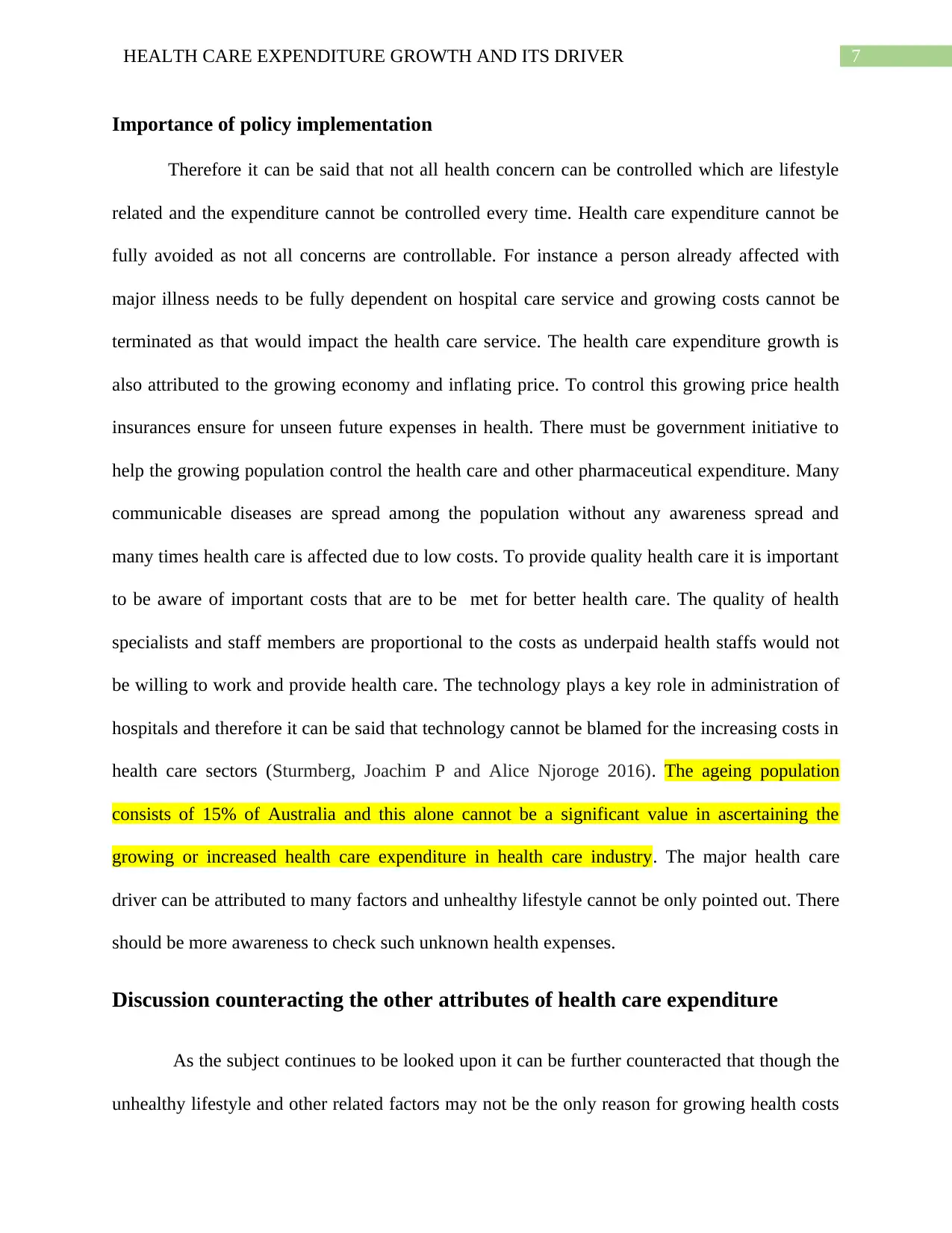
7HEALTH CARE EXPENDITURE GROWTH AND ITS DRIVER
Importance of policy implementation
Therefore it can be said that not all health concern can be controlled which are lifestyle
related and the expenditure cannot be controlled every time. Health care expenditure cannot be
fully avoided as not all concerns are controllable. For instance a person already affected with
major illness needs to be fully dependent on hospital care service and growing costs cannot be
terminated as that would impact the health care service. The health care expenditure growth is
also attributed to the growing economy and inflating price. To control this growing price health
insurances ensure for unseen future expenses in health. There must be government initiative to
help the growing population control the health care and other pharmaceutical expenditure. Many
communicable diseases are spread among the population without any awareness spread and
many times health care is affected due to low costs. To provide quality health care it is important
to be aware of important costs that are to be met for better health care. The quality of health
specialists and staff members are proportional to the costs as underpaid health staffs would not
be willing to work and provide health care. The technology plays a key role in administration of
hospitals and therefore it can be said that technology cannot be blamed for the increasing costs in
health care sectors (Sturmberg, Joachim P and Alice Njoroge 2016). The ageing population
consists of 15% of Australia and this alone cannot be a significant value in ascertaining the
growing or increased health care expenditure in health care industry. The major health care
driver can be attributed to many factors and unhealthy lifestyle cannot be only pointed out. There
should be more awareness to check such unknown health expenses.
Discussion counteracting the other attributes of health care expenditure
As the subject continues to be looked upon it can be further counteracted that though the
unhealthy lifestyle and other related factors may not be the only reason for growing health costs
Importance of policy implementation
Therefore it can be said that not all health concern can be controlled which are lifestyle
related and the expenditure cannot be controlled every time. Health care expenditure cannot be
fully avoided as not all concerns are controllable. For instance a person already affected with
major illness needs to be fully dependent on hospital care service and growing costs cannot be
terminated as that would impact the health care service. The health care expenditure growth is
also attributed to the growing economy and inflating price. To control this growing price health
insurances ensure for unseen future expenses in health. There must be government initiative to
help the growing population control the health care and other pharmaceutical expenditure. Many
communicable diseases are spread among the population without any awareness spread and
many times health care is affected due to low costs. To provide quality health care it is important
to be aware of important costs that are to be met for better health care. The quality of health
specialists and staff members are proportional to the costs as underpaid health staffs would not
be willing to work and provide health care. The technology plays a key role in administration of
hospitals and therefore it can be said that technology cannot be blamed for the increasing costs in
health care sectors (Sturmberg, Joachim P and Alice Njoroge 2016). The ageing population
consists of 15% of Australia and this alone cannot be a significant value in ascertaining the
growing or increased health care expenditure in health care industry. The major health care
driver can be attributed to many factors and unhealthy lifestyle cannot be only pointed out. There
should be more awareness to check such unknown health expenses.
Discussion counteracting the other attributes of health care expenditure
As the subject continues to be looked upon it can be further counteracted that though the
unhealthy lifestyle and other related factors may not be the only reason for growing health costs
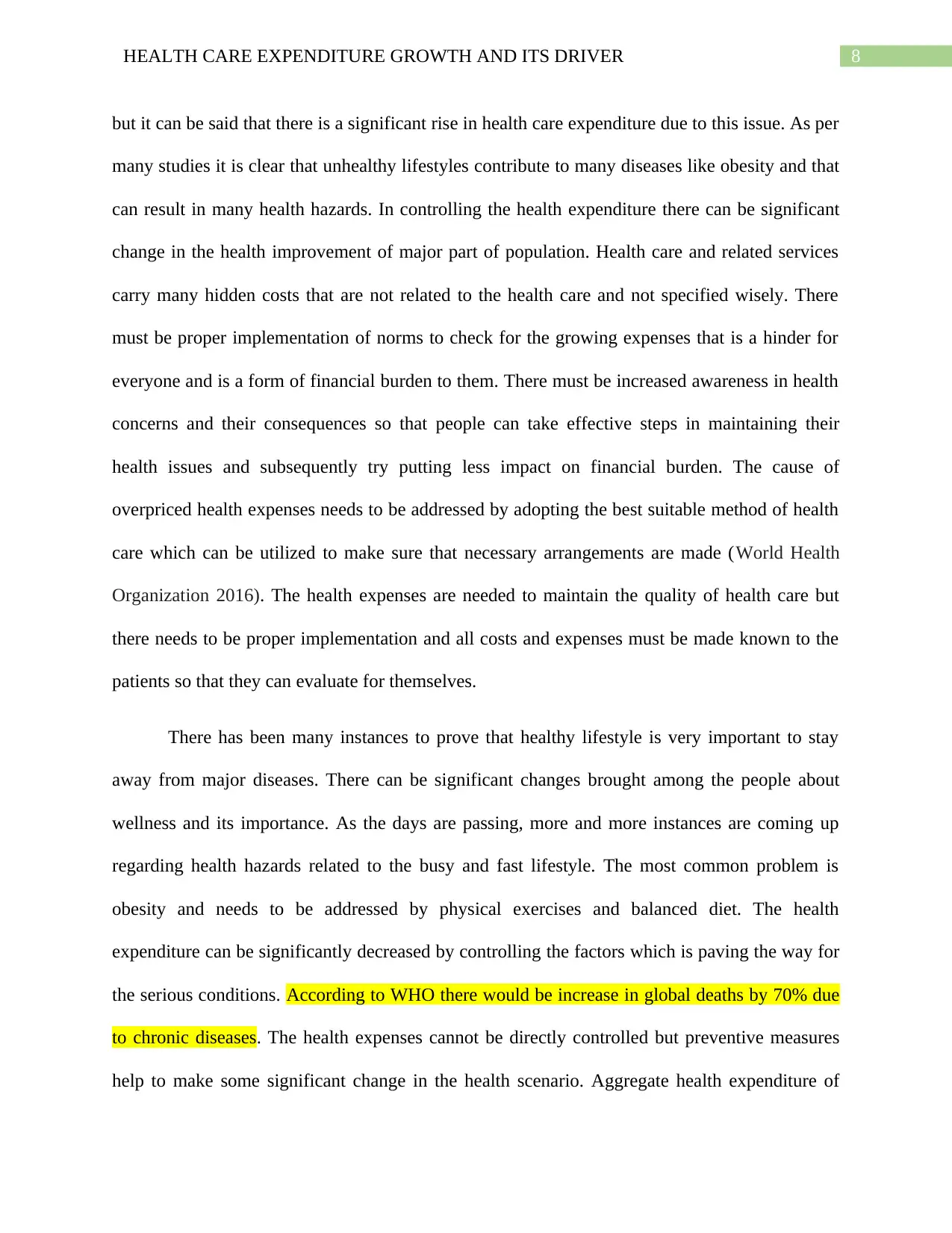
8HEALTH CARE EXPENDITURE GROWTH AND ITS DRIVER
but it can be said that there is a significant rise in health care expenditure due to this issue. As per
many studies it is clear that unhealthy lifestyles contribute to many diseases like obesity and that
can result in many health hazards. In controlling the health expenditure there can be significant
change in the health improvement of major part of population. Health care and related services
carry many hidden costs that are not related to the health care and not specified wisely. There
must be proper implementation of norms to check for the growing expenses that is a hinder for
everyone and is a form of financial burden to them. There must be increased awareness in health
concerns and their consequences so that people can take effective steps in maintaining their
health issues and subsequently try putting less impact on financial burden. The cause of
overpriced health expenses needs to be addressed by adopting the best suitable method of health
care which can be utilized to make sure that necessary arrangements are made (World Health
Organization 2016). The health expenses are needed to maintain the quality of health care but
there needs to be proper implementation and all costs and expenses must be made known to the
patients so that they can evaluate for themselves.
There has been many instances to prove that healthy lifestyle is very important to stay
away from major diseases. There can be significant changes brought among the people about
wellness and its importance. As the days are passing, more and more instances are coming up
regarding health hazards related to the busy and fast lifestyle. The most common problem is
obesity and needs to be addressed by physical exercises and balanced diet. The health
expenditure can be significantly decreased by controlling the factors which is paving the way for
the serious conditions. According to WHO there would be increase in global deaths by 70% due
to chronic diseases. The health expenses cannot be directly controlled but preventive measures
help to make some significant change in the health scenario. Aggregate health expenditure of
but it can be said that there is a significant rise in health care expenditure due to this issue. As per
many studies it is clear that unhealthy lifestyles contribute to many diseases like obesity and that
can result in many health hazards. In controlling the health expenditure there can be significant
change in the health improvement of major part of population. Health care and related services
carry many hidden costs that are not related to the health care and not specified wisely. There
must be proper implementation of norms to check for the growing expenses that is a hinder for
everyone and is a form of financial burden to them. There must be increased awareness in health
concerns and their consequences so that people can take effective steps in maintaining their
health issues and subsequently try putting less impact on financial burden. The cause of
overpriced health expenses needs to be addressed by adopting the best suitable method of health
care which can be utilized to make sure that necessary arrangements are made (World Health
Organization 2016). The health expenses are needed to maintain the quality of health care but
there needs to be proper implementation and all costs and expenses must be made known to the
patients so that they can evaluate for themselves.
There has been many instances to prove that healthy lifestyle is very important to stay
away from major diseases. There can be significant changes brought among the people about
wellness and its importance. As the days are passing, more and more instances are coming up
regarding health hazards related to the busy and fast lifestyle. The most common problem is
obesity and needs to be addressed by physical exercises and balanced diet. The health
expenditure can be significantly decreased by controlling the factors which is paving the way for
the serious conditions. According to WHO there would be increase in global deaths by 70% due
to chronic diseases. The health expenses cannot be directly controlled but preventive measures
help to make some significant change in the health scenario. Aggregate health expenditure of
⊘ This is a preview!⊘
Do you want full access?
Subscribe today to unlock all pages.

Trusted by 1+ million students worldwide
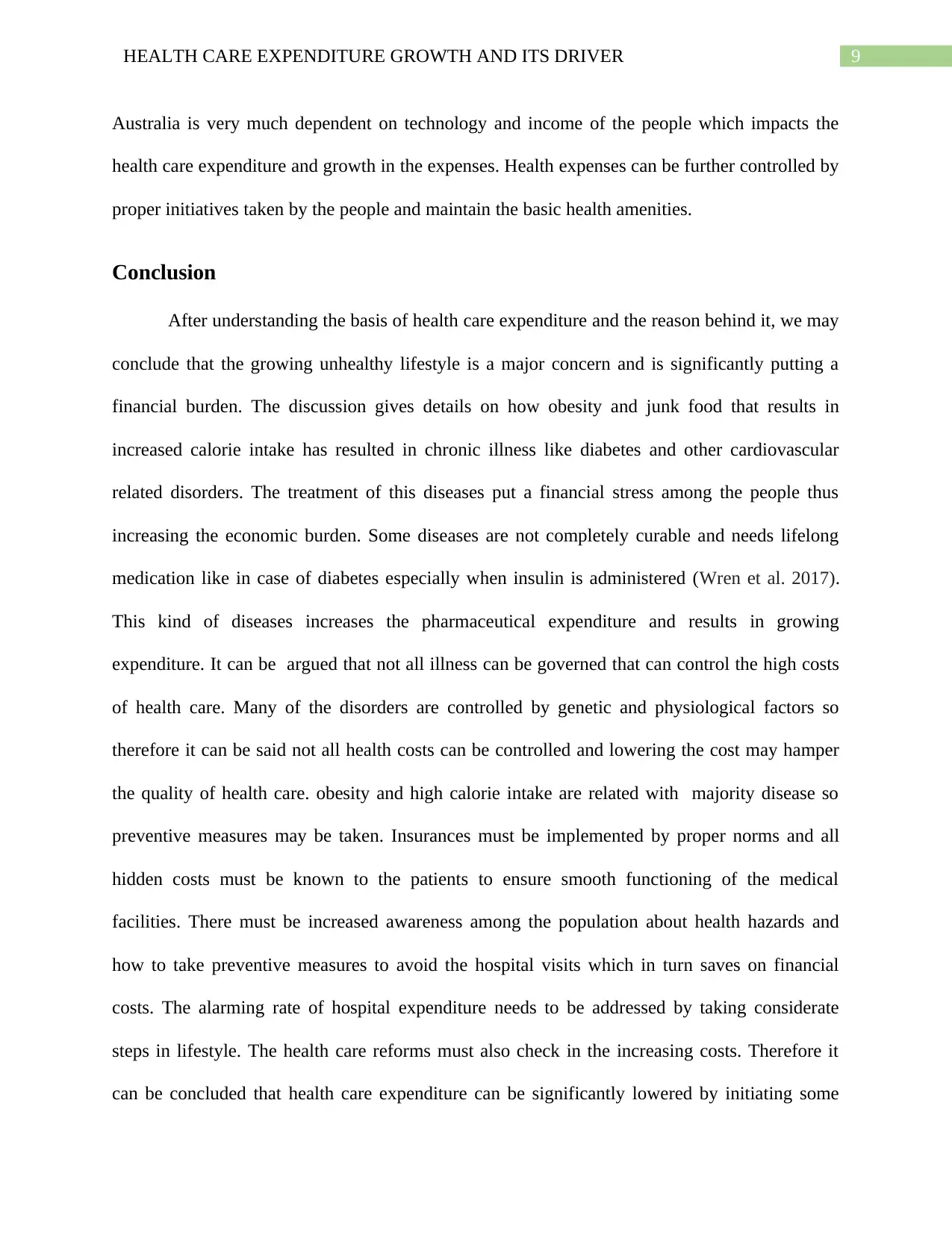
9HEALTH CARE EXPENDITURE GROWTH AND ITS DRIVER
Australia is very much dependent on technology and income of the people which impacts the
health care expenditure and growth in the expenses. Health expenses can be further controlled by
proper initiatives taken by the people and maintain the basic health amenities.
Conclusion
After understanding the basis of health care expenditure and the reason behind it, we may
conclude that the growing unhealthy lifestyle is a major concern and is significantly putting a
financial burden. The discussion gives details on how obesity and junk food that results in
increased calorie intake has resulted in chronic illness like diabetes and other cardiovascular
related disorders. The treatment of this diseases put a financial stress among the people thus
increasing the economic burden. Some diseases are not completely curable and needs lifelong
medication like in case of diabetes especially when insulin is administered (Wren et al. 2017).
This kind of diseases increases the pharmaceutical expenditure and results in growing
expenditure. It can be argued that not all illness can be governed that can control the high costs
of health care. Many of the disorders are controlled by genetic and physiological factors so
therefore it can be said not all health costs can be controlled and lowering the cost may hamper
the quality of health care. obesity and high calorie intake are related with majority disease so
preventive measures may be taken. Insurances must be implemented by proper norms and all
hidden costs must be known to the patients to ensure smooth functioning of the medical
facilities. There must be increased awareness among the population about health hazards and
how to take preventive measures to avoid the hospital visits which in turn saves on financial
costs. The alarming rate of hospital expenditure needs to be addressed by taking considerate
steps in lifestyle. The health care reforms must also check in the increasing costs. Therefore it
can be concluded that health care expenditure can be significantly lowered by initiating some
Australia is very much dependent on technology and income of the people which impacts the
health care expenditure and growth in the expenses. Health expenses can be further controlled by
proper initiatives taken by the people and maintain the basic health amenities.
Conclusion
After understanding the basis of health care expenditure and the reason behind it, we may
conclude that the growing unhealthy lifestyle is a major concern and is significantly putting a
financial burden. The discussion gives details on how obesity and junk food that results in
increased calorie intake has resulted in chronic illness like diabetes and other cardiovascular
related disorders. The treatment of this diseases put a financial stress among the people thus
increasing the economic burden. Some diseases are not completely curable and needs lifelong
medication like in case of diabetes especially when insulin is administered (Wren et al. 2017).
This kind of diseases increases the pharmaceutical expenditure and results in growing
expenditure. It can be argued that not all illness can be governed that can control the high costs
of health care. Many of the disorders are controlled by genetic and physiological factors so
therefore it can be said not all health costs can be controlled and lowering the cost may hamper
the quality of health care. obesity and high calorie intake are related with majority disease so
preventive measures may be taken. Insurances must be implemented by proper norms and all
hidden costs must be known to the patients to ensure smooth functioning of the medical
facilities. There must be increased awareness among the population about health hazards and
how to take preventive measures to avoid the hospital visits which in turn saves on financial
costs. The alarming rate of hospital expenditure needs to be addressed by taking considerate
steps in lifestyle. The health care reforms must also check in the increasing costs. Therefore it
can be concluded that health care expenditure can be significantly lowered by initiating some
Paraphrase This Document
Need a fresh take? Get an instant paraphrase of this document with our AI Paraphraser
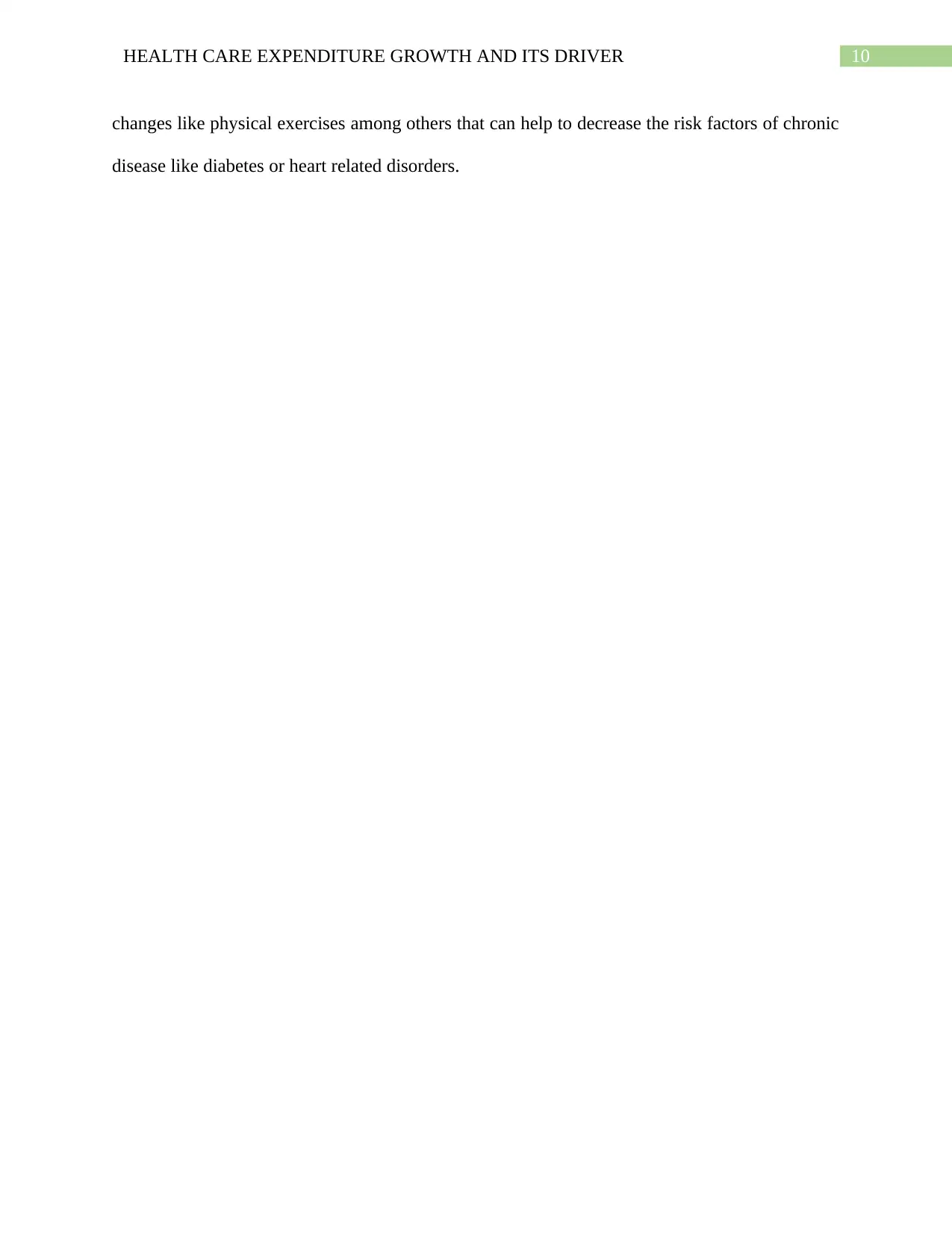
10HEALTH CARE EXPENDITURE GROWTH AND ITS DRIVER
changes like physical exercises among others that can help to decrease the risk factors of chronic
disease like diabetes or heart related disorders.
changes like physical exercises among others that can help to decrease the risk factors of chronic
disease like diabetes or heart related disorders.
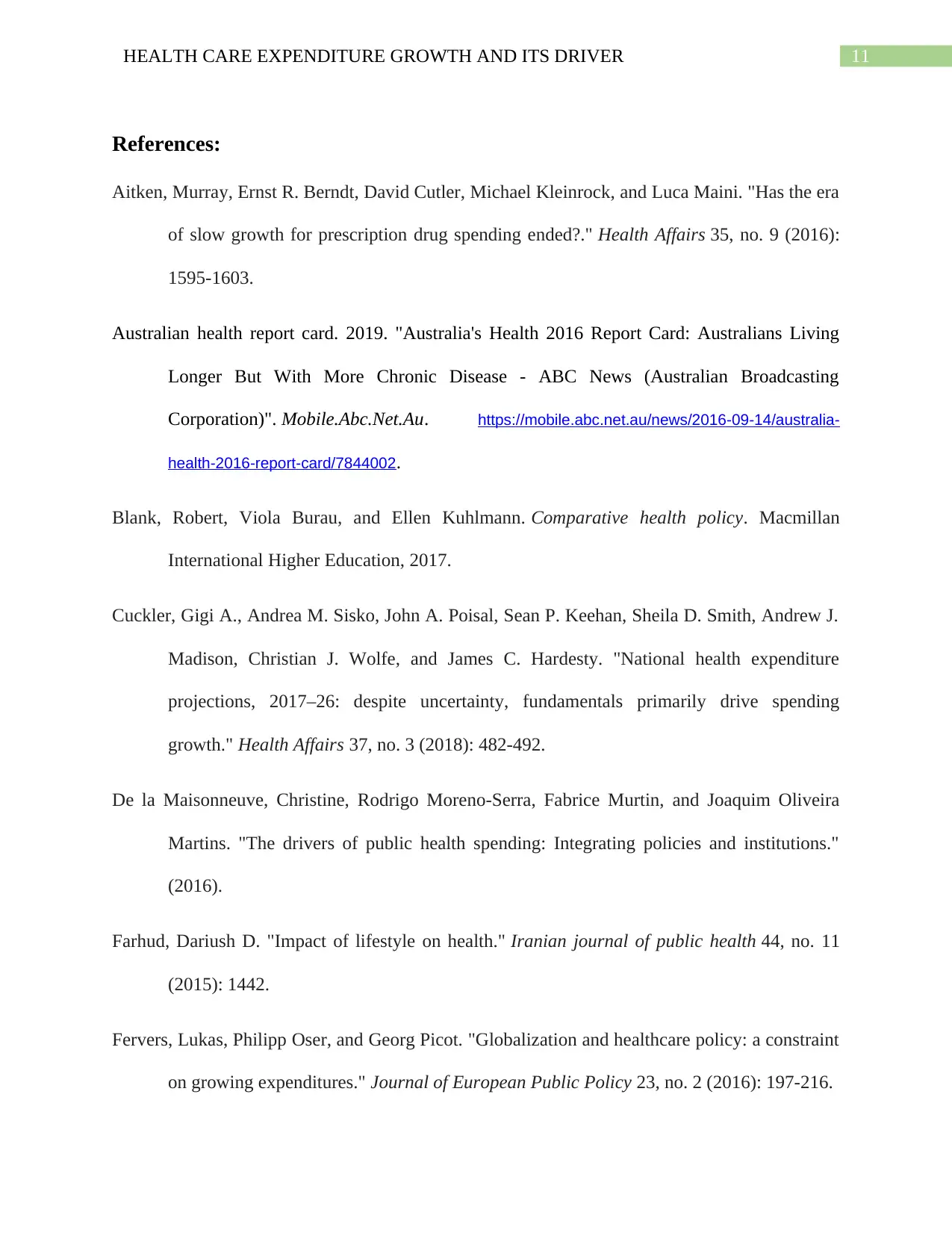
11HEALTH CARE EXPENDITURE GROWTH AND ITS DRIVER
References:
Aitken, Murray, Ernst R. Berndt, David Cutler, Michael Kleinrock, and Luca Maini. "Has the era
of slow growth for prescription drug spending ended?." Health Affairs 35, no. 9 (2016):
1595-1603.
Australian health report card. 2019. "Australia's Health 2016 Report Card: Australians Living
Longer But With More Chronic Disease - ABC News (Australian Broadcasting
Corporation)". Mobile.Abc.Net.Au. https://mobile.abc.net.au/news/2016-09-14/australia-
health-2016-report-card/7844002.
Blank, Robert, Viola Burau, and Ellen Kuhlmann. Comparative health policy. Macmillan
International Higher Education, 2017.
Cuckler, Gigi A., Andrea M. Sisko, John A. Poisal, Sean P. Keehan, Sheila D. Smith, Andrew J.
Madison, Christian J. Wolfe, and James C. Hardesty. "National health expenditure
projections, 2017–26: despite uncertainty, fundamentals primarily drive spending
growth." Health Affairs 37, no. 3 (2018): 482-492.
De la Maisonneuve, Christine, Rodrigo Moreno-Serra, Fabrice Murtin, and Joaquim Oliveira
Martins. "The drivers of public health spending: Integrating policies and institutions."
(2016).
Farhud, Dariush D. "Impact of lifestyle on health." Iranian journal of public health 44, no. 11
(2015): 1442.
Fervers, Lukas, Philipp Oser, and Georg Picot. "Globalization and healthcare policy: a constraint
on growing expenditures." Journal of European Public Policy 23, no. 2 (2016): 197-216.
References:
Aitken, Murray, Ernst R. Berndt, David Cutler, Michael Kleinrock, and Luca Maini. "Has the era
of slow growth for prescription drug spending ended?." Health Affairs 35, no. 9 (2016):
1595-1603.
Australian health report card. 2019. "Australia's Health 2016 Report Card: Australians Living
Longer But With More Chronic Disease - ABC News (Australian Broadcasting
Corporation)". Mobile.Abc.Net.Au. https://mobile.abc.net.au/news/2016-09-14/australia-
health-2016-report-card/7844002.
Blank, Robert, Viola Burau, and Ellen Kuhlmann. Comparative health policy. Macmillan
International Higher Education, 2017.
Cuckler, Gigi A., Andrea M. Sisko, John A. Poisal, Sean P. Keehan, Sheila D. Smith, Andrew J.
Madison, Christian J. Wolfe, and James C. Hardesty. "National health expenditure
projections, 2017–26: despite uncertainty, fundamentals primarily drive spending
growth." Health Affairs 37, no. 3 (2018): 482-492.
De la Maisonneuve, Christine, Rodrigo Moreno-Serra, Fabrice Murtin, and Joaquim Oliveira
Martins. "The drivers of public health spending: Integrating policies and institutions."
(2016).
Farhud, Dariush D. "Impact of lifestyle on health." Iranian journal of public health 44, no. 11
(2015): 1442.
Fervers, Lukas, Philipp Oser, and Georg Picot. "Globalization and healthcare policy: a constraint
on growing expenditures." Journal of European Public Policy 23, no. 2 (2016): 197-216.
⊘ This is a preview!⊘
Do you want full access?
Subscribe today to unlock all pages.

Trusted by 1+ million students worldwide
1 out of 14
Related Documents
Your All-in-One AI-Powered Toolkit for Academic Success.
+13062052269
info@desklib.com
Available 24*7 on WhatsApp / Email
![[object Object]](/_next/static/media/star-bottom.7253800d.svg)
Unlock your academic potential
Copyright © 2020–2025 A2Z Services. All Rights Reserved. Developed and managed by ZUCOL.





